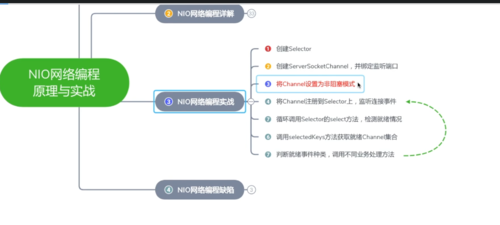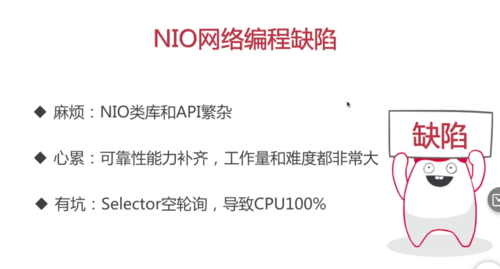课程名称: 解锁网络编程之NIO的前世今生
课程章节:第4章 【应用】NIO网络编程实战、第5章 【掌握】NIO网络编程缺陷
课程讲师: 张小喜
课程内容:
服务器端补充对其他客户端的广播
private void broadCast(Selector selector,
SocketChannel sourceChannel, String request) {
/**
* 获取到所有已接入的客户端channel
*/
Set<SelectionKey> selectionKeySet = selector.keys();
/**
* 循环向所有channel广播信息
*/
selectionKeySet.forEach(selectionKey -> {
Channel targetChannel = selectionKey.channel();
// 剔除发消息的客户端
if (targetChannel instanceof SocketChannel
&& targetChannel != sourceChannel) {
try {
// 将信息发送到targetChannel客户端
((SocketChannel) targetChannel).write(
Charset.forName("UTF-8").encode(request));
} catch (IOException e) {
e.printStackTrace();
}
}
});
}客户端的写法
public void start(String nickname) throws IOException {
/**
* 连接服务器端
*/
SocketChannel socketChannel = SocketChannel.open(
new InetSocketAddress("127.0.0.1", 8000));
/**
* 接收服务器端响应
*/
// 新开线程,专门负责来接收服务器端的响应数据
// selector , socketChannel , 注册
Selector selector = Selector.open();
socketChannel.configureBlocking(false);
socketChannel.register(selector, SelectionKey.OP_READ);
new Thread(new NioClientHandler(selector)).start();
/**
* 向服务器端发送数据
*/
Scanner scanner = new Scanner(System.in);
while (scanner.hasNextLine()) {
String request = scanner.nextLine();
if (request != null && request.length() > 0) {
socketChannel.write(
Charset.forName("UTF-8")
.encode(nickname + " : " + request));
}
}
}补充循环接受服务器端消息的线程
**
* 客户端线程类,专门接收服务器端响应信息
*/
public class NioClientHandler implements Runnable {
private Selector selector;
public NioClientHandler(Selector selector) {
this.selector = selector;
}
@Override
public void run() {
try {
for (;;) {
int readyChannels = selector.select();
if (readyChannels == 0) continue;
/**
* 获取可用channel的集合
*/
Set<SelectionKey> selectionKeys = selector.selectedKeys();
Iterator iterator = selectionKeys.iterator();
while (iterator.hasNext()) {
/**
* selectionKey实例
*/
SelectionKey selectionKey = (SelectionKey) iterator.next();
/**
* **移除Set中的当前selectionKey**
*/
iterator.remove();
/**
* 7. 根据就绪状态,调用对应方法处理业务逻辑
*/
/**
* 如果是 可读事件
*/
if (selectionKey.isReadable()) {
readHandler(selectionKey, selector);
}
}
}
} catch (IOException e) {
e.printStackTrace();
}
}
/**
* 可读事件处理器
*/
private void readHandler(SelectionKey selectionKey, Selector selector)
throws IOException {
/**
* 要从 selectionKey 中获取到已经就绪的channel
*/
SocketChannel socketChannel = (SocketChannel) selectionKey.channel();
/**
* 创建buffer
*/
ByteBuffer byteBuffer = ByteBuffer.allocate(1024);
/**
* 循环读取服务器端响应信息
*/
String response = "";
while (socketChannel.read(byteBuffer) > 0) {
/**
* 切换buffer为读模式
*/
byteBuffer.flip();
/**
* 读取buffer中的内容
*/
response += Charset.forName("UTF-8").decode(byteBuffer);
}
/**
* 将channel再次注册到selector上,监听他的可读事件
*/
socketChannel.register(selector, SelectionKey.OP_READ);
/**
* 将服务器端响应信息打印到本地
*/
if (response.length() > 0) {
System.out.println(response);
}
}
}课程收获:
通过对实战课的学习,对NIO的基本调用实现已经有了基本的了解。后续将根据工作中的场景看下是否进行应用
点击查看更多内容
为 TA 点赞
评论
共同学习,写下你的评论
评论加载中...
作者其他优质文章
正在加载中
感谢您的支持,我会继续努力的~
扫码打赏,你说多少就多少
赞赏金额会直接到老师账户
支付方式
打开微信扫一扫,即可进行扫码打赏哦






